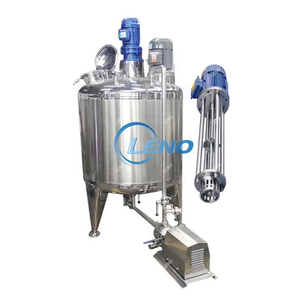
All categories
Featured selections
Trade Assurance
Buyer Central
Help Center
Get the app
Become a supplier

(1345 products available)





















































An industrial immersion blender is usually employed in the food processing industry. It has a significantly higher power output than domestic blenders because it must process large food quantities. Commercial or industrial blenders may be hand-held or fixed, depending on the application.
Based on application industry, industrial immersion blenders can be grouped into food blenders, pharmaceutical blenders, and chemical blenders.
Food blenders
In the food industry, immersion blenders are used to puree, blend, or emulsify food. They process sauces, soups, stews, smoothies, and batters. Food blenders are essential for creating smooth and consistent textures in cooked or liquidized meals. It is also used for making emulsified sauces like mayonnaise or salad dressing. These blenders can be hand-held, allowing direct immersion in food or liquid, or fixed with a blending vessel. Hand-held blenders are more common because they are easier to operate and more versatile. Chef or kitchen staff directly uses it to blend food in pots, bowls, or pans.
Pharmaceutical blenders
In pharmaceutical manufacturing, immersion blenders are used for mixing, emulsifying, or homogenizing different drug components. It processes suspensions, solutions, creams, ointments, and other pharmaceutical products. When developing or producing medication, it is essential to get uniform mixing and consistency. Industrial blenders can handle the required standards for blending pharmaceutical formulations. They have features like explosion-proof motors, hygienic designs, and precise speed control. This ensures safe and compliant operation. Using these blenders helps to improve the quality and effectiveness of pharmaceutical products.
Chemical blenders
Chemical blenders are a vital equipment for the chemical industry. They mix, homogenize, or emulsify different liquids and colloids. These blenders can process chemicals, fuels, lubricants, and coatings. It helps to create uniform mixtures in chemicals or products.
Industrial immersion blenders are specifically designed for these applications. They can withstand harsh conditions found in chemical processing. This includes high temperatures, corrosive liquids, and explosion-proof requirements. Powerful motors give precise mixing and effective results.
The functions of the varying types and models of industrial immersion blenders will often differ and the possibilities of what can be blended, pureed, or processed depend on the specific tool to undertake that job. Common functions include doing the following:
Industrial blenders are important in processing large quantities of food and beverages. There are a variety of applications for industrial blenders:
Target Consistency:
The process of choosing the right industrial immersion blender begins with identifying the kind of texture the particular application requires. If a restaurant chain is looking for a blender that can provide a shake-like consistency to sauces and soups, an unwavering blender with a smooth mixing process is the best fit. On the other hand, if food manufacturers need a rough paste-like texture in salsas, a sturdy blender that can produce chunky bits is more appropriate. Understanding the end texture required helps in making the right choice.
Batch Size and Power Need:
Next, businesses need to evaluate the total amount of ingredients to be blended at once, along with the necessary power for that. Factors like batch size, blending time, and resistance to heating should be put into consideration. Immersion blenders come in different power ratings. While smaller businesses may settle for a lower power rating, bigger firms may need a heavy-duty immersion blender that can withstand continuous use. The degree of power needed depends on the thickness of mixtures.
Stainless Steel vs. Plastic:
The choice of material for the blender is influenced by the desire for durability, resistance to heat, and hygiene. While plastic immersion blenders offer lighter weight and lower cost, they may wear out quicker with constant use. Stainless steel models provide strength but can be heavier and more costly. One of the most significant advantages of using an immersion blender with a plastic body is its ability to blend hot substances without acquiring heat. This is because the plastic sheath usually protects the motor.
Versatile Attachments:
When it comes to immersion blenders, flexibility is an essential factor to consider. This affects businesses' choices of blenders. Some models come with multiple attachments like whisks, choppers, and mixers. These additional tools allow users to expand their culinary tasks without the need for confusing separate gadgets. Considering blenders with interchangeable parts and add-ons for mixing, chopping, and pureeing is worthwhile.
Frequency of Use and Maintenance:
When it comes to picking an industrial food blender, organizations must consider how frequently they will use the device. Companies that frequently use immersion blenders in their food preparation must select durable models that can endure regular use. Infrequent users, on the other hand, can get away with using less robust models. Organizations should also think about how simple it will be to clean and maintain the blenders.
Q: What is an industrial immersion blender?
A: An industrial immersion blender is designed for large-scale food processing. Unlike traditional blenders, which blend small quantities of food, immersion blenders can blend, mix, and puree large volumes of ingredients. They are widely used in restaurants, hospitals, and food manufacturing companies.
Q: What are the benefits of using an industrial immersion blender?
A: Industrial immersion blenders are efficient, versatile, and easy to use. They save time when preparing large quantities of food. In addition to that, these blenders have multiple attachments that allow them to perform different tasks. Also, using the blender is simpler than transferring soups or sauces to a mixing bowl.
Q: What features should buyers consider when purchasing industrial immersion blenders?
A: Buyers should consider the blender's capacity, power, and speed settings. The capacity should be large enough to handle the blending requirements. A powerful blender can handle tough blending tasks, while different speed settings allow users greater control.
Q: Are industrial immersion blenders easy to maintain?
A: Yes, they are easy to maintain. Most blenders come with detailed instructions on how to clean and maintain them. Following the manufacturer's guidelines ensures the blender serves its users for many years while performing consistently.
Q: Which industries use industrial immersion blenders?
A: These blenders are used in various industries, including restaurants, catering services, food processing, and beverage manufacturing companies. They are also used in bakeries and dairy product manufacturing companies.